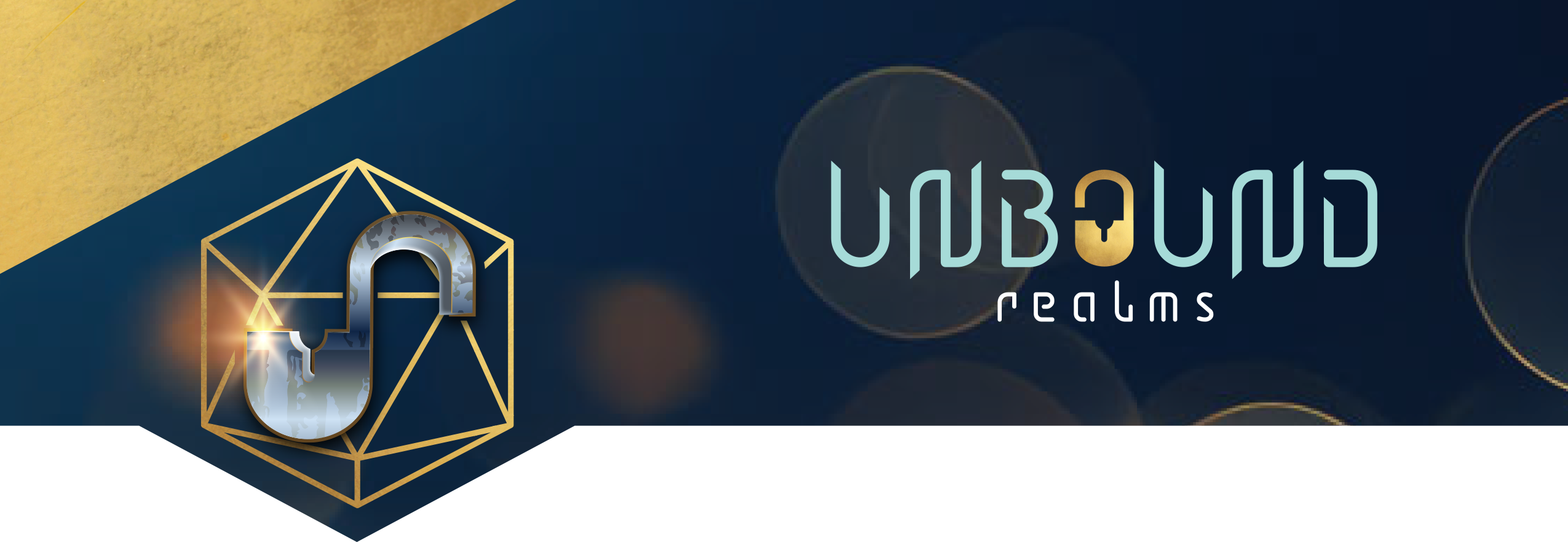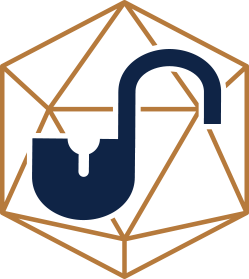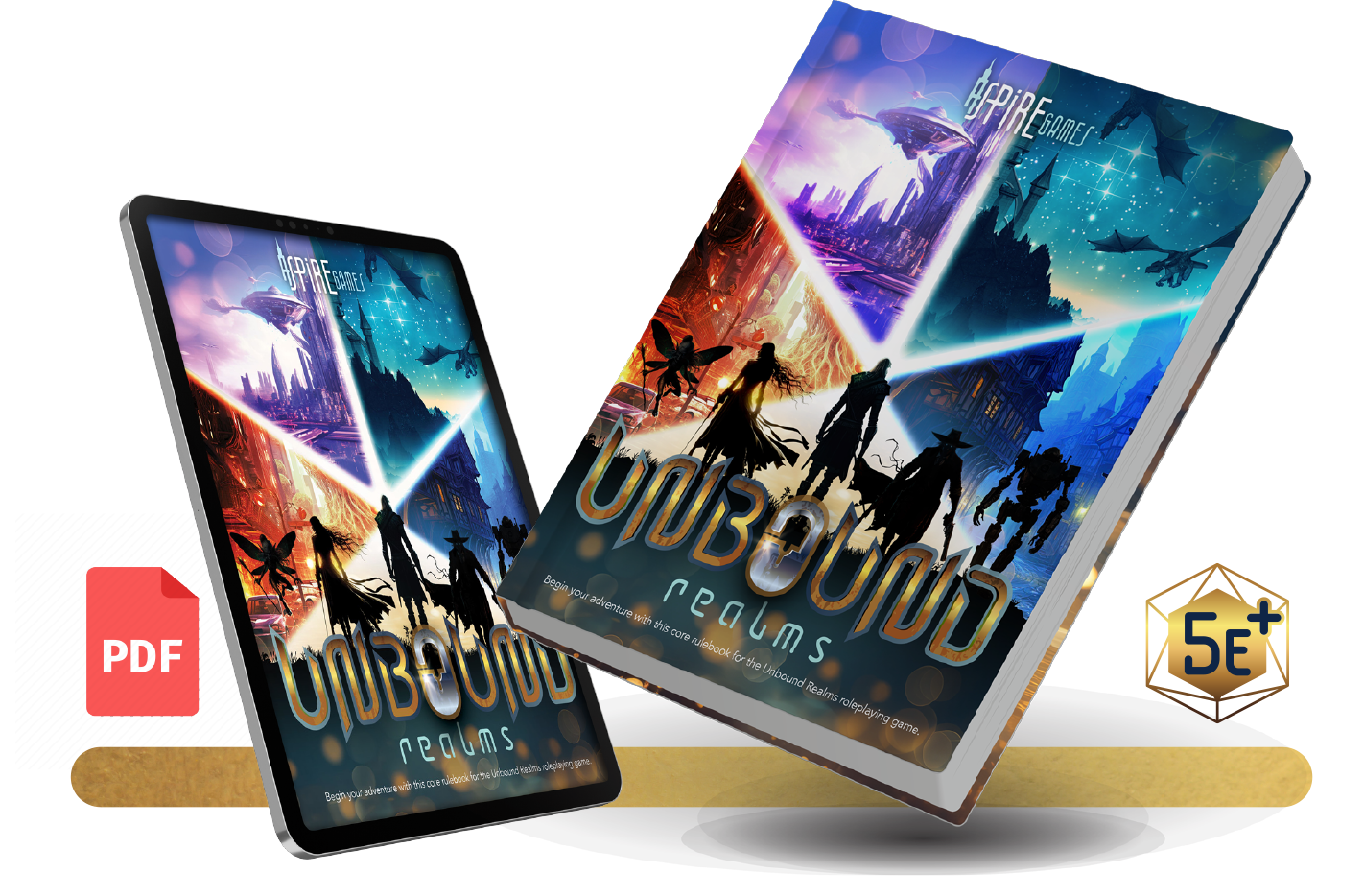
Overview
Unbound Realms is a comprehensive overhaul of the Dungeons and Dragons 5th Edition experience emphasizing three key values: customization, modularity, and versatility:
Customization
Unbound Realms introduces an unparalleled number of options, designed to bring any reasonable character to life.
- Subclass and Invocations: Each class is enriched with a variety of subclasses and an invocation system, allowing you to tailor your character’s abilities to your liking.
- Traits and Feats: Characters start with traits based on their species, background, and class, and gain more as they level. Plus, everyone has access to feats, offering even more ways to customize your character.
- Battleforms and Styles: From casting styles to battle forms and fighting styles, Unbound Realms ensures that your preferred play style is fully supported.
Each book beyond the first will introduce more character options, be they subclasses and invocations, traits and feats, or more unique customization options.
Modularity
Throughout each book, and consolidated in an appendix, there is a slew of optional variant rules, that let you tweak and adjust the game to your table. For instance, in prior editions there were penalties for casting spells in armor. While that's not a core rule of Unbound Realms, it is a variant option.
Versatility
Unlike other systems, Unbound Realms is designed to work in any setting—such as The Wheel of Time or The Dresden Files—you can imagine. Whether you want to run a superhero campaign, a sci-fi epic, a wild west adventure, or a traditional sword and sorcery quest, Unbound Realms provides the tools to make it happen.
We'll be introducing our own Open Gaming Licenses to encourage those who want to use our rules in their settings to create their own setting guides. With enough options, one single ruleset can work for innumerable different games.
Roadmap
Unbound Realms has a roadmap featuring a total of six intended books. Each book beyond the first is optional and only requires the first book to function, though they can work alongside each other should you choose to use more than one.
Book 1: Unbound Realms
The core rulebook lays the foundation for the system. It establishes the essential rules for creating characters and playing the game, ensuring you have everything you need to dive into your adventures.
Book 2: Unbound Ships
The first expansion in the series will introduce a whole new dimension to your campaigns—ships. Whether sailing the seas, soaring through the skies, or navigating the stars, this book will provide the mechanics to create, upgrade, and operate ships.
Book 3: Unbound Cities
This expansion will bring cities to life by introducing expanded mechanics for factions and downtime, along with enhanced rules for items, tools, and crafting.
Book 4: Unbound Strongholds
This expansion will introduce rules for establishing, owning, and upgrading strongholds. It will also delve into the mechanics of mass combat, advanced vehicle and mounted combat, and attracting NPCs to work for your characters.
Book 5: Unbound Monsters
This expansion will focus on creatures that populate worlds. It will introduce updated mechanics for encounter generation and ways to modify encounters with modular monster roles and enhancements, as well as monstrous character options that occur “in addition to” rather than “instead of” classes, such as vampirism and lycanthropy.
Book 6: Unbound Roles
This expansion will emphasize character options and GM tools. It will introduce the companion system, enabling a second less-powerful character for a PC. It will also introduce more GM tools, as well as frameworks for creating your own.

Book 1 Overview
Below you'll find an overview of the book by chapter and appendix, emphasizing the changes from 5e.
Chapter 1: Step-By-Step Characters
This is a walkthrough on building characters. Only notable change is that standard is 27-point-buy or array for generating characters.
Chapter 2: Species
Species are generated using a point-buy system, illustrated in Appendix H. Species are slightly weaker than 5e, but backgrounds are significantly stronger.
Chapter 3: Backgrounds
Backgrounds are also generated using a point-buy system, illustrated in Appendix I. Backgrounds are significantly stronger to account for slightly weaker species.
Chapter 4: Classes
- Subclasses: Subclass levels are homogenized; each subclass grants two features at 3rd level and one feature each at 6th, 10th, 14th, and 18th level, potentially facilitating using a subclass from a different class.
- Invocations: Each class has a second level of customization that varies by class.
- Customization: Classes can be heavily customized using a variant rule.
The Arcanists
These are your spellcasters.
- The Archon: The “full” spellcaster that can cast as rituals and has “channel divinity” options as its invocation.
- The Channeler: The “three-quarters” spellcaster that uses their Hit Dice to create effects and focuses on debuffing enemies as their invocation.
- The Magus: The “half” spellcaster that focuses on using their weapon to cast and has deployable sigils as their invocation.
The Focused
These all use a point system like Ki.
- The Berserker: It’s barbarian with a lot of polish.
- The Mystic: It’s monk with a lot of polish.
- The Operative: It’s rogue with a lot of polish.
The Psionicists
These are your psicasters, similar to the Force classes from SW5e.
- The Esper: The “full” psicaster that can overpower their talents and use metamagics.
- The Ardent: The “three-quarters” psicaster that uses their points for battlefield fluidity.
- The Battlemind: The “half” psicaster that is basically a paladin.
The Superior
These all use superiority dice and tactics.
- The Scholar: The “full” superior that can holds its own or support its allies.
- The Specialist: The “three-quarters” superior that focuses on utilizing consumables.
- The Champion: The “half” superior, champions are a polished fighter.
The Technologists
These are the techcasters.
- The Engineer: The “full” techcaster that improves and modifies gear and experiments with tech.
- The Artist: The “three-quarters” techcaster that focuses on a support and buff role.
- The Scout: The “half” techcaster that is an evolved ranger.
Chapter 5: Customization Options
Unbound Realms places a much bigger emphasis on customization options that can be granted by classes but are otherwise class agnostic.
- Feats are split into two tiers: minor and major. Characters get a major feat at 4th, 8th, 12th, and 16th class level and a minor feat at 1st (from background), 6th, 10th, 14th, 18th level. They get a +1 ASI at 4, 8, 12, and 16, instead of +2. More ASIs can be gained from feats.
- Battleforms: These are combat-oriented bonus actions.
- Casting and Fighting Styles: There are 12 casting style trees and 40 fighting style trees. Each has three components (Dabble -> Practice -> Technique) that emphasize bonus actions and reactions. You can mix and match rather than staying within the same tree.
- Trait Points: At each proficiency bonus jump, you earn 4 trait points (5th, 9th, 13th, and 17th level) which can be freely spent on species and background traits to let you improve existing traits or gain new ones.
Chapter 6: Equipment
Unbound Realms changes or otherwise enhances many key components to equipment.
- Armor: AC now scales with proficiency bonus (8 + pb + Dex instead of flat 10 + Dex). Armor no longer provides AC, but instead provides DR. Medium and heavy armor still restrict adding Dex to AC. Light, medium, and heavy shields exist to add to AC.
- Weapons: Weapons are generated using a zero—sum calculator in appendix J. We've created a lot more robust and engaging weapon properties.
- Adventuring gear: Lots of new adventuring gear that is now categorized by the tool that makes it rather than arbitrary sections.
- Tools: More tools and new crafting rules. Tools will also be expanded on in a later book.
Chapter 7: Using Ability Scores
Unbound Realms introduces a number of tweaks to abilities.
- Ability test is a new keyword that encompasses ability checks, attack rolls, and saving throws.
- Primary saving throws have been consolidated into Fortitude, Reflex, and Will. You gain proficiency in one from your class and you can gain more from traits. You use Strength or Con for Fort, Dex or Int for Reflex, and Wis or Cha for Will.
- Concentration, Death, and Exertion saving throws are three saving throws that add Con but are not Fortitude saving throws. Concentration and Death replace their counterparts from 5e.
- Skills have been tweaked and increased to 20. Some are new, others are consolidated.
- Boon and bane dice define those bonus dice you can add, or subtract, from a roll. You can only have one at a time, like with advantage.
- Minimum and maximum roll thresholds add floors and ceilings to die rolls.
- You can only ever add two ability modifiers (or the same modifier twice) to an ability test, your AC, or your save DC.
Chapter 8: Adventuring
Unbound Realms overhauls many aspects of adventuring.
- New rules for jumping and vaulting and encumbrance.
- Crashing rules similar to falling.
- Rules for gravities and pressure environments.
- Updated rules/nerfing of darkvision.
- Overhauled resting and introduced Quick Rests, which are 1 minute and spammable. Short Rests are limited to two per long rest.
Chapter 9: Combat
Unbound Realms dramatically increases the options available to characters in combat.
- Surprise has been split into two parts: ambush and surprise. I think this should make it clearer how it works.
- Bonus actions will be/have been renamed minor actions to help reduce confusion.
- Object interaction is better defined than 5e and you only have one, like action, minor action, and reaction.
- New tier of difficult terrain in extreme terrain that costs 3 extra feet of movement, instead of 1.
- New combat actions.
- Attack replacers (grapple, shove) for every skill.
- Double-bladed weapons use Double Weapon Fighting.
- Overhauled Partial Cover and added Elevation and Flanking rules that work like Cover.
- New damage types, each with 1+ leveled conditions associated with it. A “Paired Damage, Saving Throw, and Condition” table for easy reference of features.
- Updated rules for damage reduction.
- Overhauled Death and Dying. Rules for Injuries.
- Clarified rules for things like temporary hit points or resources and similar effects.
- Overhauled and expanded Concentration.
Chapter 10: Casting, Superiority, Focus, and Effects
This chapter focuses on defining all of the shared characteristics of each school so they don’t have to be repeated for every class and subclass.
Appendix A: Arcanic Spells
When you gain spellcasting, you choose your origin from occult, primal, or sacred, which determines what spells you can easily learn and what ability modifier you use for casting.
Appendix B: Psionic Talents
Empathic talents use Wisdom as your casting ability, psychic talents use Charisma, and agnostic use your choice of the two.
Appendix C: Superior Tactics
Physical tactics use your choice of Strength, Dex, or Con as your maneuver ability while mental use your choice of Int, Wis, or Cha. General use your choice from any.
Appendix D: Tech Modules
When you gain techcasting, you choose two of the following subtypes: hardware, software, and wetware. The cost in tech points to cast one of your choices is reduced by 1, and the cost for the other is increased.
Appendix E: Conditions
Conditions have been split into Beneficial and Detrimental, or Buffs and Debuffs. There are 30+ new conditions with tracks that encourage strategic gameplay. It’s hard to simplify these so it’s worth just reading them.
Appendix F: Variant Rules
This is a compendium of variant rules that can be used to modify the game for a table.
Appendix G: Monster Statistics
This will be series of 50 or so monsters that utilize things like the new armor rules and damage types.
Appendix H: Species Generation
This is a walkthrough for generating a species using our point-buy system.
Appendix I: Background Generation
This is a walkthrough for generating a background using our point-buy system.
Appendix J: Weapon Generation
This is a walkthrough for generating a weapon using our zero-sum system.



